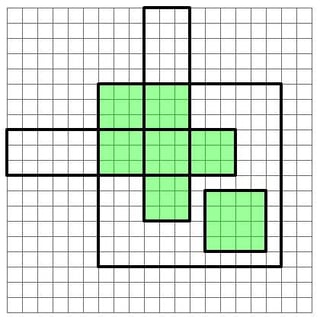Imagine a bunch of rectangles drawn in the plane, each rectangle with its vertices at integer coordinates and its sides parallel to the axes:

The rectangles partition the plane into a number of disjoint regions, coloured red and blue below:

Your goal is to find the number of such regions which are perfect squares. In the example above, there are three:

Note that the big square in the middle is not counted as it is not a single region, but is instead made up of several smaller disjoint regions.
Input
You may write a function or a full program for this challenge.
Input will be 4n nonnegative integers defining n rectangles in the plane. Each rectangle is represented by two opposing vertices, e.g. 4 9 7 8 represents the rectangle with opposing vertices (4, 9) and (7, 8). Note that this rectangle could also be represented as 7 8 4 9 or 4 8 7 9.
The exact input format is flexible (e.g. space-separated string, comma-separated string, single array of integers, list of coordinate tuples, and so on) but please be reasonable and give an example of how to run your code in your post. You may not reorder the input.
For simplicity, you can assume that no two edges will be overlapping — this includes overlapping at a vertex. In particular, this implies that no two rectangles will be touching edge-to-edge or corner-to-corner, and the rectangles will have nonzero area.
Output
Your program should print or return a single integer, which is the number of square regions.
Scoring
This is code golf, so the code in the fewest bytes wins.
Test cases
Input:
0 0 5 5
6 8 10 4
14 16 11 13
19 1 18 2
Output:
4
This is simply four disjoint squares:

Input:
2 1 3 11
1 10 5 19
6 10 11 3
8 8 15 15
13 13 9 5
15 1 19 7
17 19 19 17
Output:
3
This is the example test case at the start of the post.
Input:
0 9 15 12
6 3 18 15
9 6 12 20
13 4 17 8
Output:
7

Input:
5 9 11 10
5 12 11 13
6 8 7 14
9 8 10 14
13 8 14 9
13 10 14 14
Output:
14

Input:
0 99999 100000 0
Output:
0
This is just one big rectangle.
Input:
0 99999 100000 0
2 1 142857 285714
Output:
1
Two big rectangles which overlap.
